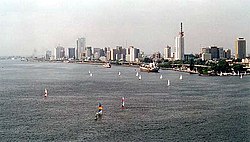Lagos
Lagos is the second largest city in Africa and the most populous city in Nigeria and in West Africa. There are about 12.5 million to 18 million people living in Lagos, which makes it one of the biggest cities in Africa. Lagos is surrounded by the Atlantic Ocean. The city of lagos mainland is made of several local government areas. Some of these areas are Somolu Koshofe, Ifelodun, Surulere, Agege, Ikeja, Ikorodu, Ajegunle, Oshodi, and Maryland.[8][9][10] The Lagos Island consists of Ikoyi (Eti Osa) , Victoria Island, Lekki, Ajah, Ibeju Lekki, and Sangotedo. Other Parts of Lagos city-state include : Epe, Ikorodu, and badagry.
| |
|---|---|
Metropolis | |
Lagos Metropolitan Area
| |
 | |
|
| |
|
| |
 The location of Lagos in the State of Lagos | |
| Coordinates: 6°27′18″N 3°23′03″E / 6.455027°N 3.384082°ECoordinates: 6°27′18″N 3°23′03″E / 6.455027°N 3.384082°E | |
| Country | |
| State | Lagos |
| LGA(s)[note 1] | List of LGAs
|
| Settled | 15th century |
| Founded by | Awori subgroup of the Yoruba |
| Government | |
| • Oba | Rilwan Akiolu I |
| Area | |
| • Metropolis | 1,171.28 km2 (452.23 sq mi) |
| • Land | 999.6 km2 (385.9 sq mi) |
| • Water | 171.68 km2 (66.29 sq mi) |
| • Urban | 907 km2 (350 sq mi) |
| • Metro | 2,706.7 km2 (1,045.1 sq mi) |
| Elevation | 41 m (135 ft) |
| Population (2006 census) | |
| • Metropolis | 8,048,430 |
| • Estimate (2012 by LASG) | 16,060,303[6] |
| • Rank | 1st |
| • Density | 6,871/km2 (17,800/sq mi) |
| • Urban | 13,123,000[5] |
| • Urban density | 14,469/km2 (37,470/sq mi) |
| • Metro | 21,000,000 (estimated) |
| • Metro density | 7,759/km2 (20,100/sq mi) |
| GDP | |
| Time zone | UTC+1 (WAT (UTC+1)) |
| Climate | Aw |
| |
Each Local government area has a presence of the central government with the establishment of general hospital, judiciary and police stations.
Lagos was the capital of Nigeria until 1992, when the capital became Abuja. Lagos is still the commercial capital of Nigeria and a gateway to West Africa. Lagos is made up of different islands like Victoria island, Banana island, Snake island, and the mainland.
Lagos Media
A map showing the 16 LGAs making up Lagos Metropolitan Area
Eko Atlantic, a project at the mouth of Lagos Lagoon under construction, extending and further developing Victoria Island (imaged from Tarkwa Bay Beach)
Notes
References
- ↑ "18th National Sports Festival: Lagos unveils Logo, mascot and website". Premium Times (Abuja, Nigeria). 18 June 2012. http://premiumtimesng.com/sports/5817-18th-national-sports-festival-lagos-unveils-logo-mascot-and-website.html. Retrieved 2 October 2012.
- ↑ "Eko 2012: Building Branding through Sports, Articles". ThisDay (Lagos, Nigeria). 22 August 2012. Archived from the original on 24 December 2013. https://web.archive.org/web/20131224112111/http://www.thisdaylive.com/articles/eko-2012-building-branding-through-sports/122890/. Retrieved 2 October 2012.
- ↑ 3.0 3.1 "Metro Lagos (Nigeria): Local Government Areas". City Population. 21 March 2015. Retrieved 26 October 2015.
- ↑ "Lagos and Its Potentials for Economic Growth". 2 July 2015. Retrieved 26 October 2015.
- ↑ Demographia (January 2015). Demographia World Urban Areas (PDF) (11th ed.). Retrieved 2 March 2015.
- ↑ "Population-Lagos State". Lagos State Government. Archived from the original on 18 October 2015. Retrieved 21 February 2016.
- ↑ Williams, Lizzie (2008). Bradt Travel Guides (3rd ed.). Paperback. p. 87. ISBN 978-1-8416-2397-9. Retrieved 26 July 2014.
- ↑ Writer, Staff. "Africa's biggest shipping ports". Retrieved 2021-05-04.
- ↑ Rajewski, Brian (1999). Cities of the World: Africa. Gale. ISBN 978-0-8103-7692-2.
- ↑ Campbell, John (2012-07-10). "This Is Africa's New Biggest City: Lagos, Nigeria, Population 21 Million". The Atlantic. Retrieved 2021-05-04.











